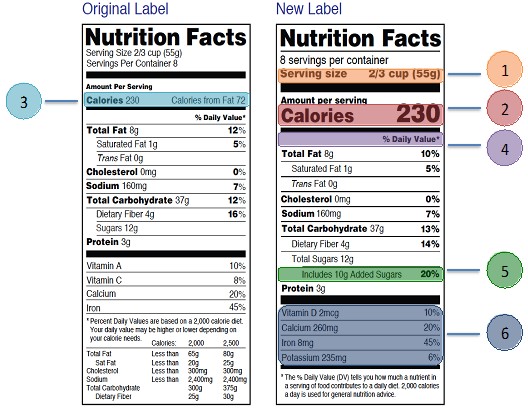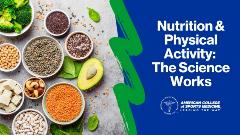Laura Young, MS, ACSM-CPT |
Jan.
20, 2021

What are the major changes to the new food label?
It has been almost 20 years since the U.S. Food and Drug Administration (FDA) has updated the Food Label1. With updated scientific information, new nutrition research, and input from the public the FDA has made design and content changes to the food nutrition labels seen on packaged foods and drinks1.
As a health care professional, educator, or consumer learning the details of the new nutrition facts label is key to making informed nutrition choices.

Serving sizes have been updated to better reflect the amount people typically eat or drink today. The serving size is not a recommendation of how much to eat but a realistic reflection of what many Americans actually eat and drink. For instance, the serving size for ice cream was previously ½ cup and now it is ¾ cup.

This change to the food label should make the information easier to find and use.

Research shows the type of fat consumed is more important than the amount3.

The %DV is how much a nutrient in a serving of food contributes to a total daily diet. This explanation also has been updated to better explain the %DV at the bottom of the new food label in a footnote. For example, the Daily Value (DV) for sodium is 2,300 milligrams (mg).
If one serving of a pasta dish contains 1,150 mg of sodium, the %DV for sodium would be 50%.
When deciding if a food has a high or low percentage of a nutrient, many nutrition professionals use the 5 and 20 rule. A product with 5% DV or less is considered low, and 20% DV or more of a nutrient per serving is considered high. This can be of assistance when comparing food products. Going back to the above pasta example, a single serving of pasta with a 50% DV for sodium would indicate the pasta dish is high in sodium, as it is above 20% DV according to the 5 and 20 rule.

The amount of Added Sugars are now required on the new food label. Consuming too much added sugars can make it difficult to meet nutrient needs while staying within calorie limits. Added sugars include sugars that are added during the processing of foods (such as sucrose or dextrose), foods packaged as sweeteners (such as table sugar), sugars from syrups and honey and sugars from concentrated fruit or vegetable juices. They do not include naturally occurring sugars that are found in milk, fruits and vegetables. The Daily Value for added sugars is 50 grams per day based on a 2,000 calorie daily diet.
Total sugars include naturally present sugars in many foods and beverages such as the sugar in milk and fruits as well as any added sugars that may be present in the product. There is no Daily Value for total sugars because no recommendation has been made for the total amounts to each in a day.

Vitamin D and Potassium are now required on the new food label. This is because Americans often fall short of the recommended amounts.
Diets higher in vitamin D and potassium can reduce the risk of osteoporosis and high blood pressure, respectively.
Vitamin A and Vitamin C are no longer required. Deficiencies of these nutrients are rare today so they will no longer be displayed on food labels4.
What has stayed the same?
Calcium and iron will continue to be listed on the label because the majority of Americans do not meet the recommended daily amounts. Diets higher in calcium and iron can reduce the risk of osteoporosis and anemia, respectively.
How to use the new information on the food label?
Use the new food label to promote and choose foods that are high in:
Food choices are directly linked to higher risks for developing certain health conditions such as high blood pressure, cardiovascular disease, various cancers, osteoporosis and anemia3. Making informed nutrition choices promotes a healthier lifestyle, longevity and lowers disease risk.
The FDA also has an education campaign to raise awareness about changes to the new food label. Additional education resources such as adverts, video and consumer friendly downloadable materials are available at: fda.gov.
Author: Laura Young, MS, ACSM-CPT, is currently a doctoral student at the University of Utah. She is also the science assistant at ACSM, under Lynette Craft Ph.D., Chief Science Officer.
View More Popular Nutrition Content

3 Nutrition FAQs | Fitness Essentials

Nutrition Resources
References:
1. Food and Drug Administration. (2020). The New Nutrition Facts Label. Center for Food Safety and Applied Nutrition. [cited 2021 January 20]. Available from: https://www.fda.gov/food/nutrition-education-resources-materials/new-nutrition-facts-label
2. U.S. Centers for Disease Control and Prevention. (2012, April). Second National Report on Biochemical Indicators of Diet and Nutrition in the U.S. Population 2012. National Center for Environmental Health, Division of Laboratory Sciences.
3. U.S. Department of Agriculture. (December 2015). 2015-2020 Dietary Guidelines for Americans. 8th Edition. U.S. Department of Health and Human Services. [cited 2021 January 20]. Available from: https://health.gov/our-work/food-and-nutrition/2015-2020-dietary-guidelines/.
4. U.S. Centers for Disease Control and Prevention. (2012, April 2). CDC’s Second Nutrition Report: A comprehensive biochemical assessment of the nutrition status of the U.S. population. National Center for Environmental Health/Division of Laboratory Sciences. [cited 2021 January 20]. Available from: https://www.cdc.gov/nutritionreport/pdf/4page_%202nd%20nutrition%20report_508_032912.pdf